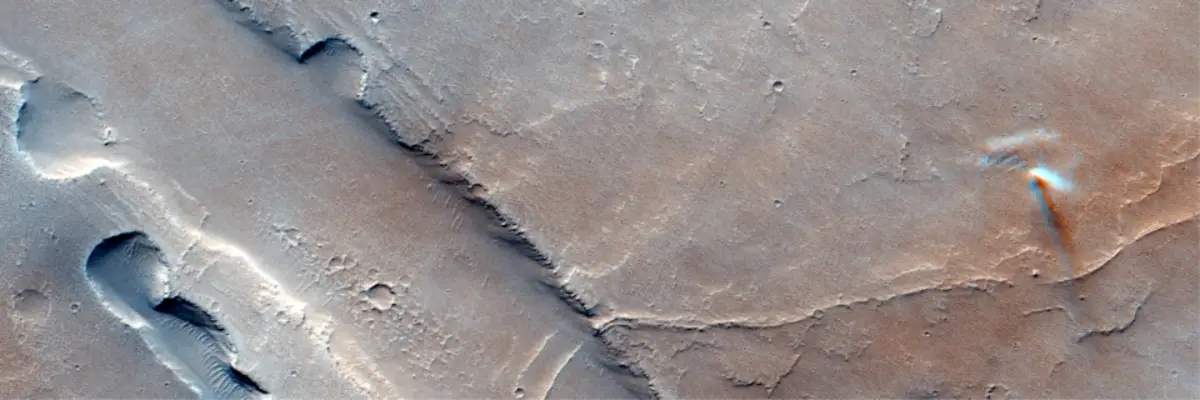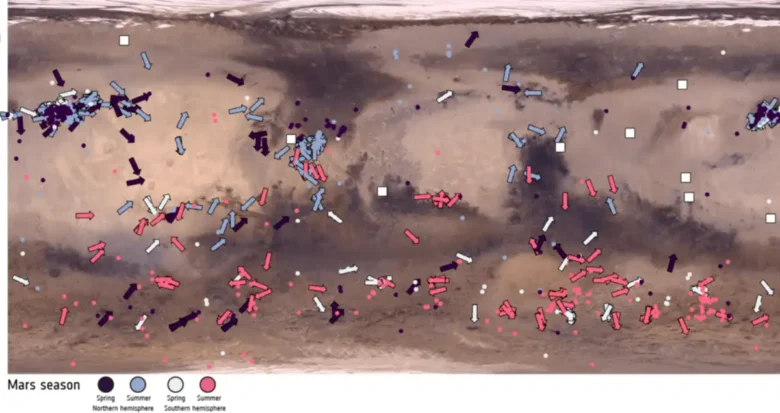| Summary |
|
Scientists using ESA’s Mars Express and ExoMars Trace Gas Orbiter have tracked more than a thousand dust devils across the Martian surface, revealing winds far stronger than expected. The study, published in Science Advances, shows that these spinning columns of dust can reach speeds up to 158 kilometers per hour. The findings help researchers understand how Martian weather works and how it could affect future missions.
Dust devils form when warm air rises through cooler air, creating rotating vortices that lift dust from the ground. On Mars, they leave visible streaks behind as they clear fine material from the surface. Unlike on Earth, they thrive in an atmosphere just one percent as dense, yet they are strong enough to move dust high into the sky.
The new survey catalogued 1,039 dust devils, the first time scientists have been able to map them on a global scale. Many were found in dusty plains such as Amazonis Planitia. The study shows that some whirlwinds wobble as they move, changing direction unexpectedly. Seasonal patterns also emerged, with activity peaking in the Martian spring and summer, between late morning and early afternoon.
To measure wind speed, researchers used a neural network to identify dust devils in two decades of images from the orbiters. The spacecraft’s cameras, designed to photograph the surface, occasionally recorded the same scene several seconds apart.
Dust devils shifted between these exposures, and scientists used that displacement to calculate speed and direction. Mars Express provided delays of up to 19 seconds, while ExoMars’ CaSSIS camera offered longer delays of up to 46 seconds, making movement easier to track.

Some dust devils were clocked at 44 meters per second, faster than anything previously measured by rovers on the surface. These high speeds mean that dust storms on Mars may carry more material than current models predict, affecting the climate and shaping how the thin atmosphere evolves over time.
Dust plays an important role in Mars’ environment. It cools the surface during the day, warms the air at night, and can seed clouds. On a larger scale, storms can lift water vapor into the upper atmosphere, where it may escape into space. The dust also impacts robotic missions. Accumulation on solar panels reduces power, as seen with NASA’s InSight lander, which shut down in 2022 after losing too much energy.
Understanding when and where dust devils occur could help engineers select safer landing sites and design more resilient equipment. The new catalog shows where activity is most common and provides data for improving climate models.
The researchers also highlighted how these dust devils are not evenly spread across the planet. While Amazonis Planitia produced many of them, areas such as Hellas Basin recorded fewer, likely because of less loose material. Some whirlwinds were also observed on the slopes of giant Martian volcanoes, showing that elevation does not prevent them from forming.
Future work will focus on combining observations from both orbiters taken at the same time, which could confirm speed calculations. As the catalog grows, scientists expect to refine models of Martian weather, helping prepare for both robotic and eventual human missions.
Mars Express and ExoMars continue to send back images, adding new examples of dust devils to the record every week. Researchers say these findings are a step toward understanding how winds shape the planet’s surface and atmosphere.
Sources: Dancing dust devils trace raging winds on Mars; Dust devil migration patterns reveal strong near-surface winds across Mars

